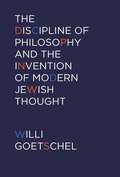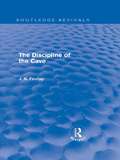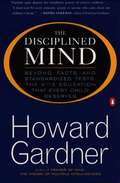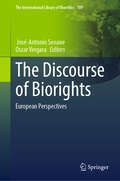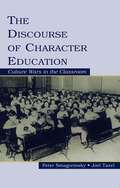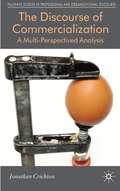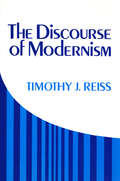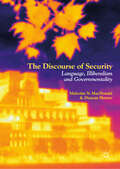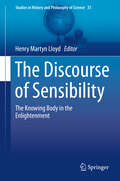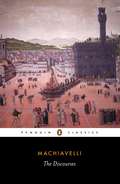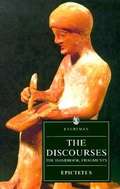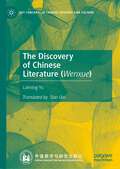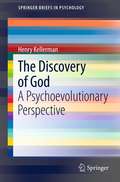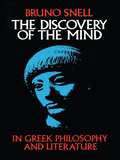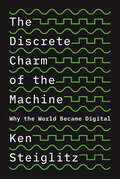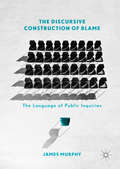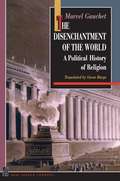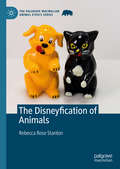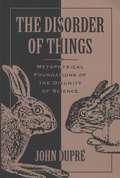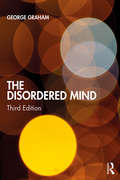- Table View
- List View
The Discipline of Philosophy and the Invention of Modern Jewish Thought
by Willi GoetschelExploring the subject of Jewish philosophy as a controversial construction site of the project of modernity, this book examines the implications of the different and often conflicting notions that drive the debate on the question of what Jewish philosophy is or could be.The idea of Jewish philosophy begs the question of philosophy as such. But “Jewish philosophy” does not just reflect what “philosophy” lacks. Rather, it challenges the project of philosophy itself.Examining the thought of Spinoza, Moses Mendelssohn, Heinrich Heine, Hermann Cohen Franz Rosenzweig, Martin Buber, Margarete Susman, Hermann Levin Goldschmidt, and others, the book highlights how the most philosophic moments of their works are those in which specific concerns of their “Jewish questions” inform the rethinking of philosophy’s disciplinarity in principal terms.The long overdue recognition of the modernity that informs the critical trajectories of Jewish philosophers from Spinoza and Mendelssohn to the present emancipates not just “Jewish philosophy” from an infelicitous pigeonhole these philosophers so pointedly sought to reject but, more important, emancipates philosophy from its false claims to universalism.
The Discipline of the Cave (Routledge Revivals)
by John Niemeyer FindlayFirst published in 1966, The Discipline of the Cave is the first series of a course of Gifford lectures on philosophical issues.. J N Findlay’s lectures use the image of the Cave to show how familiarity is full of restrictions, and involves puzzles and discrepancies unable to be resolved or removed. Such philosophical perplexities may be a result of the misunderstanding and abuse of ordinary ways of thinking and speaking. They may also be a way of ‘drawing us towards being’, providing proof of the absurdity of ordinary thought, speech and experience unless modified and added to in ways which may point beyond it. What may be called a mystical and otherworldly element may need to be introduced into or rendered explicit in all our experience in order to give a viable sense to the most commonplace human utterances and activities.
The Disciplined Mind: Beyond Facts Standardized Tests K 12 Educ That Every Child Deserves
by Howard Gardner<P>Howard Gardner's concept of multiple intelligences has been hailed as perhaps the most profound insight into education since the work of Jerome Bruner, Jean Piaget, and, even earlier, John Dewey.<P> Now in The Disciplined Mind, Gardner pulls together the threads of his previous works in a major new synthesis aimed at parents, educators, and the general public alike.<P> The Disciplined Mind looks beyond such parochial issues as charters, vouchers, unions, and affirmative action in order to explore the larger questions of what an educated person should be and how such an education can be achieved for all students.<P> Gardner eloquently argues that the purpose of K-12 education should be to enhance students' deep understanding of truth (and falsity), beauty (and ugliness), and goodness (and evil) as defined by their various cultures. With this stance, Gardner transforms the tired debate between "traditionalists" and "progressives.".
The Disclosure of Politics
by Maria Pia LaraMaría Pía Lara explores the ambiguity of secularization and the theoretical potential of a structural break between politics and religion. For Lara, secularization means the translation of religious semantics into politics; a transformation of religious notions into political ideas; and the reoccupation of a space left void by changing political actors, one that gives rise to new conceptions of political interaction. Conceptual innovation redefines politics as a horizontal relationship between governments and the governed, better enabling societies (and political actors) to articulate meaning through action.
The Disclosure of Politics: Struggles Over the Semantics of Secularization (New Directions in Critical Theory #35)
by Maria LaraPostmodern political critiques speak of the death of ideology, the end of history, and the postsecular return of religious attitudes, yet radical conservative theorists such as Mark Lilla argue religion and politics are inextricably intertwined. Returning much-needed uncertainty to debates over the political while revitalizing the very terms in which they are defined, María Pía Lara explores the ambiguity of secularization and the theoretical potential of a structural break between politics and religion.For Lara, secularization means three things: the translation of religious semantics into politics; a transformation of religious notions into political ideas; and the reoccupation of a space left void by changing political actors that gives rise to new conceptions of political interaction. Conceptual innovation redefines politics as a horizontal relationship between governments and the governed and better enables societies (and individual political actors) to articulate meaning through action—that is, through the emergence of new concepts. These actions, Lara proves, radically transform our understanding of politics and the role of political agents and are further enhanced by challenging the structural dependence of politics on religious phenomena.
The Discourse of Biorights: European Perspectives (The International Library of Bioethics #109)
by José-Antonio Seoane Oscar VergaraThis book provides answers to the questions that biomedical and biotechnological research has posed to our societies by proposing the introduction of biorights. It shows how bioscience affects our individual and social lives by discussing and answering important questions such as; Are we becoming more vulnerable and unable to protect ourselves? How can we ensure fairness and justice with regards to the access to health care? Are human dignity, autonomy and equality at risk? Do we need new and special rights: neurorights, genetic rights? What is the meaning and scope of the right to life, health, privacy or non-discrimination? Biorights are the suggested solution for dealing with these challenges. Healthcare professionals, bio-researchers, policy makers, scholars, and citizens will, in this book, find a guide to knowing how bioscience affects our lives. Furthermore, this book provides a comprehensive method for biomedical and biotechnological decision-making that comprises human or basic rights dimensions alongside technical and ethical dimensions. Chapters 1, 12 and 18 are available open access under a Creative Commons Attribution 4.0 International License via link.springer.com.
The Discourse of Character Education: Culture Wars in the Classroom
by Peter Smagorinsky Joel TaxelIn this book Peter Smagorinsky and Joel Taxel analyze the ways in which the perennial issue of character education has been articulated in the United States, both historically and in the current character education movement that began in earnest in the 1990s. The goal is to uncover the ideological nature of different conceptions of character education. The authors show how the current discourses are a continuation of discourse streams through which character education and the national purpose have been debated for hundreds of years, most recently in what are known as the Culture Wars--the intense, often passionate debates about morality, culture, and values carried out by politicians, religious groups, social policy foundations, and a wide range of political commentators and citizens, in which the various stakeholders have sought influence over a wide range of social and economic issues, including education. The centerpiece is a discourse analysis of proposals funded by the United States Department of Education's Office of Educational Research and Improvement (OERI). Discourse profiles from sets of states that exhibit two distinct conceptions of character are examined and the documents from particular states are placed in dialogue with the OERI Request for Proposals. One profile reflects the dominant perspective promoted in the U.S., based on an authoritarian view in which young people are indoctrinated into the value system of presumably virtuous adults through didactic instruction. The other reflects the well-established yet currently marginal discourse emphasizing attention to the whole environment in which character is developed and enacted and in which reflection on morality, rather than didactic instruction in morality, is the primary instructional approach. By focusing on these two distinct regions and their conceptions of character, the authors situate the character education movement at the turn of the twenty-first century in the context of historical notions about the nature of character and regional conceptions regarding the nature of societal organization. This enlightening volume is relevant to scholars, practitioners, policymakers, and students across the field of education, particularly those involved in character education, moral development, discourse analysis, history and cultural foundations of education, and related fields, and to the wider public interested in character education.
The Discourse of Commercialization
by Jonathan CrichtonAn examination of how the commercialization of professional practice is implicated in its organizational discourses. Drawing on a study of ELT colleges, the book explores how teaching practices are permeated and challenged by a 'discourse of commercialization' through which market priorities become normative in teachers' professional lives.
The Discourse of Modernism
by Timothy J. ReissTimothy J. Reiss perceives a new mode of discourse emerging in early seventeenth-century Europe; he believes that this form of thought, still our own, may itself soon be giving way. In The Discourse of Modernism, Reiss sets up a theoretical model to describe the process by which one dominant class of discourse is replaced by another. He seeks to demonstrate that each new mode does not constitute a radical break from the past but in fact develops directly from its predecessor.
The Discourse of Security: Language, Illiberalism And Governmentality (Postdisciplinary Studies in Discourse)
by Malcolm N. MacDonald Duncan HunterThis book explores how language constructs the meaning and praxis of security in the 21st century. Combining the latest critical theories in poststructuralist and political philosophy with discourse analysis techniques, it uses corpus tools to investigate four collections of documents harvested from national and international security organisations. This interdisciplinary approach provides insights into the ways in which discourse has been mobilised to construct a strategic response to major terrorist attacks and geo-political events. The authors identify the way in which it is used to realize tactics of governmentality and form security as a discipline. This at once constructs a state of exception while also adhering to the principles of liberalism. This insightful study will be of particular interest to students and scholars of subjects such as applied linguistics, political science, security studies and international relations, with additional relevance to other areas including law, criminology, sociology and economics.
The Discourse of Sensibility
by Henry Martyn LloydThis volume reconstructs the body of sensibility and the discourse which constructed it. The discourse of sensibility was deployed very widely throughout the mid- to late-eighteenth century, particularly in France and Britain. To inquire into the body of sensibility is then necessarily to enter into an interdisciplinary space and so to invite the plurality of methodological approaches which this collection exemplifies. The chapters collected here draw together the histories of literature and aesthetics, metaphysics and epistemology, moral theory, medicine, and cultural history. Together, they contribute to four major themes: First, the collection reconstructs various modes by which the sympathetic subject was construed or scripted, including through the theatre, poetry, literature, and medical and philosophical treaties. It secondly draws out those techniques of affective pedagogy which were implied by the medicalisation of the knowing body, and thirdly highlights the manner in which the body of sensibility was constructed as simultaneously particular and universal. Finally, it illustrates the 'centrifugal forces' at play within the discourse, and the anxiety which often accompanied them. At the centre of eighteenth-century thought was a very particular object: the body of sensibility, the Enlightenment's knowing body. The persona of the knowledge-seeker was constructed by drawing together mind and matter, thought and feeling. And so where the Enlightenment thinker is generally associated with reason, truth-telling, and social and political reform, the Enlightenment is also known for its valorisation of emotion. During the period, intellectual pursuits were envisioned as having a distinctly embodied and emotional aspect. The body of 'sensibility' encompassed these apparently disparate strands and was associated with terms including 'sentimental', 'sentiment', 'sense', 'sensation', and 'sympathy'.
The Discourses
by Niccolo MachiavelliFew figures in intellectual history have proved as notorious and ambiguous as Niccolò Machiavelli. But while his treatise The Prince made his name synonymous with autocratic ruthlessness and cynical manipulation, The Discourses (c.1517) shows a radically different outlook on the world of politics. In this carefully argued commentary on Livy’s history of republican Rome, Machiavelli proposed a system of government that would uphold civic freedom and security by instilling the virtues of active citizenship, and that would also encourage citizens to put the needs of the state above selfish, personal interests. Ambitious in scope, but also clear-eyed and pragmatic, The Discourses creates a modern theory of republic politics.Leslie J. Walker’s definitive translation has been revised by Brian Richardson and is accompanied by an introduction by Bernard Crick, which illuminates Machiavelli’s historical context and his new theories of politics. This edition also includes suggestions for further reading and notes.
The Discourses of Epictetus
by Epictetus Robin Hard Christoper GillThe Everyman Paperback Classics series offers the latest scholarship on the works of the world's greatest poets, writers and philosophers. Each edition includes a comprehensive introduction, chronology, notes, appendix, critical responses, and a text summary.
The Discovery of Chance: The Life and Thought of Alexander Herzen
by Aileen M. KellyThe intellectual Alexander Herzen was as famous in his day as Tolstoy and Dostoevsky. Aileen Kelly presents the first fully rounded study of the farsighted genius whom Isaiah Berlin called the forerunner of much twentieth-century thought. For Herzen, history, like Darwinian nature, was an improvisation both constrained and encouraged by chance.
The Discovery of Chinese Literature (Key Concepts in Chinese Thought and Culture)
by Laiming YuThis book traces the origin and evolvement of two Chinese characters “wenxue”(literature) by using the methods of conceptual history and historical and cultural semantics, and by taking the evolution and changes of the concept of the these two characters and their interpretations in the west as a window, and re-examining the contemporary morphology of concept evolution in the historical context of concept generation and development to discover the historical and cultural connotations hidden behind the characters, so as to embark on a vivid journey to explore the history of literary thought, discipline and culture. The entire book is woven with the concept of “literature” at its core. Following the author's analysis and interpretation, an interlocking and orderly network of description of ancient and modern, Chinese and foreign unfolds. In this context, the chapters are progressive and mutually responsive, forming an organic whole which is connected at the beginning and the end. For those readers who are trying to understand how Chinese “wenxue” evolved from one of the “four disciplines of Confucius” into a modern discipline and concept, this book will provide the most detailed, in-depth, and vivid historical picture.
The Discovery of Freedom: Man's Struggle Against Authority
by Rose Wilder Lane(from Introduction) This is a revolutionary work. It picks up and develops the individualistic aspects of the American political thought of Thomas Paine, Thomas Jefferson, James Madison, James Wilson, George Mason and others, which so strangely dropped into neglect in the aftermath of the French Revolution in the 1790s. Disregarding a few intellectuals who failed to excite the imaginations of their fellows, let alone any significant number of Americans, nothing of the originality and power of the American revolutionaries has appeared until the publication of this book. The Discovery of Freedom was first published during the Second World War. Rose Wilder Lane told me that the publishers made no effort to promote the book. Its total sales were tiny even for that period, and doubly so for a book written by a nationally known literary figure whose career had encompassed investigative journalism, the publication of hundreds of short stories and articles, and a number of recent novels that had placed high on the best seller lists. Nonetheless, the book did circulate, often dog-eared copies passed from hand to hand and did influence many people. Along with Ayn Rand's different approach to the basis of freedom, it was the seminal force creating the current wide trend toward individualistic views in America. Henry Grady Weaver produced an adaptation and popularization of the book, which appeared under the title The Mainspring of Human Progress, which subsequently sold hundreds of thousands of copies.
The Discovery of God
by Henry KellermanThe debate between theist and atheist is an old one and has recently become a highly publicized one. There are some well known proponents of arguments on both sides. To provide a different perspective this book takes a psychoanalytically based evolutionary view, presenting an entirely original theoretical concept. It introduces an epigenetic component to the discussion of God/no God within the context of evolutionary processes at the point where a thinking brain appears -- a cerebral cortex characteristic of homosapien. Therefore, it joins evolutionary phenomena with psychological realities for survival and safety, for empowerment and the absence of disempowerment. Research is cited to show that such instinctive survival behavior involves several prototypical behavioral categories relevant to all organisms from amoeba to man. Freud, Darwin, Gould, and the major historical figures of the God/no God debate are included throughout, and the point is made that environmental conditions can produce biological effects and this is the essence of the proposed epigenetical context of the debate. Therefore, this volume concerns itself with exploring the question of whether there is a God-gene or whether God is discovered epigentically in a psycho/evolutionary context. In either case, this book does not argue for the existence or non-existence of God. Rather, it introduces a new dimension to the debate -- a psycho/evolutionary one.
The Discovery of Things: Aristotle's Categories and Their Context
by Wolfgang-Rainer MannAristotle's Categories can easily seem to be a statement of a naïve, pre-philosophical ontology, centered around ordinary items. Wolfgang-Rainer Mann argues that the treatise, in fact, presents a revolutionary metaphysical picture, one Aristotle arrives at by (implicitly) criticizing Plato and Plato's strange counterparts, the "Late-Learners" of the Sophist. As Mann shows, the Categories reflects Aristotle's discovery that ordinary items are things (objects with properties). Put most starkly, Mann contends that there were no things before Aristotle. The author's argument consists of two main elements. First, a careful investigation of Plato which aims to make sense of the odd-sounding suggestion that things do not show up as things in his ontology. Secondly, an exposition of the theoretical apparatus Aristotle introduces in the Categories--an exposition which shows how Plato's and the Late-Learners' metaphysical pictures cannot help but seem inadequate in light of that apparatus. In doing so, Mann reveals that Aristotle's conception of things--now so engrained in Western thought as to seem a natural expression of common sense--was really a hard-won philosophical achievement. Clear, subtle, and rigorously argued, The Discovery of Things will reshape our understanding of some of Aristotle's--and Plato's--most basic ideas.
The Discovery of the Mind: in Greek Philosophy and Literature
by Bruno SnellEuropean thinking began with the Greeks. Science, literature, ethics, philosophy -- all had their roots in the extraordinary civilization that graced the shores of the Mediterranean a few millennia ago. The rise of thinking among the Greeks was nothing less than a revolution; they did not simply map out new areas for thought and discussion, they literally created the idea of man as an intellectual being -- an unprecedented concept that decisively influenced the subsequent evolution of European thought.In this immensely erudite book, German classicist Bruno Snell traces the establishment of a rational view of the nature of man as evidenced in the literature of the Greeks -- in the creations of epic and lyric poetry, and in the drama. Here are the crucial stages in the intellectual evolution of the Greek world: the Homeric world view, the rise of the individual in the early Greek lyric, myth and reality in Greek tragedy, Greek ethics, the origin of scientific thought, and Arcadia.Drawing extensively on the works of Homer, Pindar, Archilochus, Aristophanes, Sappho, Heraclitus, the Greek tragedians, Parmenides, Callimachus, and a host of other writers and thinkers, Snell shows how the Homeric myths provided a blueprint for the intellectual structure the Greeks erected; how the notion of universality in Greek tragedy broadened into philosophical generalization; how the gradual unfolding of the concepts of intellect and soul provided the foundation for philosophy, science, ethics, and finally, religion.Unquestionably one of the monuments of the Geistegeschichte (History of Ideas) tradition, The Discovery of the Mind throws fresh light on many long-standing problems and has had a wide influence on scholars of the Greek intellectual tradition. Closely reasoned, replete with illuminating insight, the book epitomizes the best in German classical scholarship -- a brilliant exploration of the archetypes of Western thought; a penetrating explanation of how we came to think the way we do.
The Discrete Charm of the Machine: Why the World Became Digital
by Ken SteiglitzThe genesis of the digital idea and why it transformed civilizationA few short decades ago, we were informed by the smooth signals of analog television and radio; we communicated using our analog telephones; and we even computed with analog computers. Today our world is digital, built with zeros and ones. Why did this revolution occur? The Discrete Charm of the Machine explains, in an engaging and accessible manner, the varied physical and logical reasons behind this radical transformation.The spark of individual genius shines through this story of innovation: the stored program of Jacquard’s loom; Charles Babbage’s logical branching; Alan Turing’s brilliant abstraction of the discrete machine; Harry Nyquist’s foundation for digital signal processing; Claude Shannon’s breakthrough insights into the meaning of information and bandwidth; and Richard Feynman’s prescient proposals for nanotechnology and quantum computing. Ken Steiglitz follows the progression of these ideas in the building of our digital world, from the internet and artificial intelligence to the edge of the unknown. Are questions like the famous traveling salesman problem truly beyond the reach of ordinary digital computers? Can quantum computers transcend these barriers? Does a mysterious magical power reside in the analog mechanisms of the brain? Steiglitz concludes by confronting the moral and aesthetic questions raised by the development of artificial intelligence and autonomous robots.The Discrete Charm of the Machine examines why our information technology, the lifeblood of our civilization, became digital, and challenges us to think about where its future trajectory may lead.
The Discursive Construction of Blame: The Language of Public Inquiries
by James MurphyThis book examines the language of public inquiries to reveal how blame is assigned, avoided, negotiated and discussed in this quasi-legal setting. In doing so, the author adds a much-needed linguistic perspective to the study of blame – previously the reserve of moral philosophers, sociologists and psychologists – at a time when public inquiries are being convened with increasing frequency. While the stated purpose of a public inquiry is rarely to apportion blame, this work reveals how blame is nevertheless woven into the fabric of the activity and how it is constructed by the language of the participants. Its chapters systematically analyse the establishment of inquiries, their questioning patterns, how blame can be avoided by witnesses, how blame is assigned or not by an inquiry’s panel and how such blame may result in public apologies. The author concludes with an engaging discussion on the value of public inquiries in civic life and suggestions for changes to the processes of public inquiries. This book will appeal to readers with a general interest in public and political language; in addition to scholars across the disciplines of communication, media studies, politics, sociology, social policy, philosophy, psychology, linguistics, rhetoric, public relations and public affairs.
The Disenchantment of the World: A Political History of Religion
by Marcel GauchetMarcel Gauchet has launched one of the most ambitious and controversial works of speculative history recently to appear, based on the contention that Christianity is "the religion of the end of religion." In The Disenchantment of the World, Gauchet reinterprets the development of the modern west, with all its political and psychological complexities, in terms of mankind's changing relation to religion. He views Western history as a movement away from religious society, beginning with prophetic Judaism, gaining tremendous momentum in Christianity, and eventually leading to the rise of the political state. Gauchet's view that monotheistic religion itself was a form of social revolution is rich with implications for readers in fields across the humanities and social sciences.Life in religious society, Gauchet reminds us, involves a very different way of being than we know in our secular age: we must imagine prehistoric times where ever-present gods controlled every aspect of daily reality, and where ancestor worship grounded life's meaning in a far-off past. As prophecy-oriented religions shaped the concept of a single omnipotent God, one removed from the world and yet potentially knowable through prayer and reflection, human beings became increasingly free. Gauchet's paradoxical argument is that the development of human political and psychological autonomy must be understood against the backdrop of this double movement in religious consciousness--the growth of divine power and its increasing distance from human activity.In a fitting tribute to this passionate and brilliantly argued book, Charles Taylor offers an equally provocative foreword. Offering interpretations of key concepts proposed by Gauchet, Taylor also explores an important question: Does religion have a place in the future of Western society? The book does not close the door on religion but rather invites us to explore its socially constructive powers, which continue to shape Western politics and conceptions of the state.
The Disneyfication of Animals (The Palgrave Macmillan Animal Ethics Series)
by Rebecca Rose StantonThis book critically examines how Walt Disney Animation Studios has depicted – and sometimes failed to depict – different forms of harming and objectifying non-human animals in their films. Each chapter addresses a different form of animal harm and objectification through the theories of speciesism, romanticism, and the ‘collapse of compassion’ effect, from farming, hunting and fishing, to clothing, work, and entertainment. Stanton lucidly presents the dichotomy between depictions of higher order, anthropomorphised and neotonised animal characters and that of lower-order species, showing furthermore how these depictions are closely linked to changing social attitudes about acceptable forms of animal harm. An engaging and novel contribution to the field of Critical Animal Studies, this book explores the use of animals not only in Disney’s best known animated films such as 101 Dalmatians, but also lesser known features including Home on the Range and Fun and Fancy Free. A quantitative appendix supplying data on how often each animal species appears and the amount of times animal harm or objectification is depicted in over fifty films provides an invaluable resource and addition to scholars working in both Disney and animal studies.
The Disorder of Things: Metaphysical Foundations of the Disunity of Science
by John DupreThe great dream of philosophers and scientists for millennia has been to give us a complete account of the order of things. A powerful articulation of such a dream in this century has been found in the idea of a unity of science. With this manifesto, John Dupré systematically attacks the ideal of scientific unity by showing how its underlying assumptions are at odds with the central conclusions of science itself. In its stead, the author gives us a metaphysics much more in keeping with what science tells us about the world. Elegantly written and compellingly argued, this provocative book will be important reading for all philosophers and scholars of science.
The Disordered Mind
by George GrahamThe Disordered Mind, Third Edition is a wide-ranging introduction to the philosophy of mental disorder or illness. It examines and explains, from a philosophical standpoint, what mental disorder is: its reality, causes, consequences, compassionate treatment, and more. Revised and updated throughout, the third edition includes enhanced discussions of the distinction between mental health and illness, selfhood and delusions about the self, impairments of basic psychological capacities in mental disorder and the distinct roles that mental causation and neural mechanisms play in mental illness. The book is organized around four questions: What is a mental disorder or illness? What makes mental disorder something bad? What are various mental disorders and what do they tell us about the mind? What is mental health and how may it be restored? Numerous disorders are discussed including: addiction, agoraphobia, delusion, depression, dissociative identity disorder, obsession-compulsion, schizophrenia, and religious scrupulosity, among others. Several neurological disorders are examined. Various problems associated with DSM-5 and with psychiatric diagnosis are explored. Including chapter summaries and suggestions for further reading, The Disordered Mind is an ideal text for courses in philosophy and should appeal to not just philosophers, but to readers in cognitive science, psychology, psychiatry and related mental health professions.
